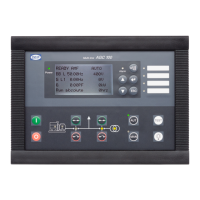9. PID controller (AGC 110 only)
9.1 General purpose of PID regulators (AGC 110 only)
9.1.1 Introduction
The controller in the AGC 110 is a PID controller. It consists of a proportional regulator, an integral regulator
and a differential regulator. The PID regulators have been designed to be as close as possible to the PID
regulators known from the AGC-4 and the AGC 200. However, the PID regulators in the AGC 110 do not
have as quick a response as the PID regulators found in the AGC-4 and AGC 200. It is therefore recommen-
ded that the PID regulators in the AGC 110 are used in applications that in general have a slow closed loop
only.
All three regulators are 100 % identical. Only parameters and M-Logic inputs/outputs are different. However,
note that only PID1 is able to run the engine in idle mode.
9.1.2 Principle drawing
The drawing below shows the basic principle of the PID controller.
P-part
(Kp)
I-part
(Ti)
D-part
(Td)
OutputSet point Σ Σ
-
++
+
sTd
sTi
Kp
1
1sPID
As illustrated in the drawing and the equation above, each regulator (P, I and D) gives an output which is
summarised to the total controller output.
The adjustable settings for the PID controllers in the AGC 110 unit are:
Kp : The gain for the proportional part.
Ti : The integral action time for the integral part.
Td : The differential action time for the differential part.
The function of each part is described in the following.
9.1.3 Proportional regulator
When the regulation deviation occurs, the proportional part will cause an immediate change of the output.
The size of the change depends on the gain Kp.
The diagram shows how the output of the P regulator depends on the Kp setting. The change of the output at
a given Kp setting will be doubled, if the regulation deviation doubles.
AGC 100 Designer's Reference Handbook
4189340766 UK
PID controller (AGC 110 only)
DEIF A/S Page 141 of 152

